Evergreens are popular in many landscapes around the DC Metro area because they keep yards looking great even in the cold winter months. Although Evergreens can add life to a dreary winter landscape, they do attract certain insects, diseases, and fungi. Read on to learn the most common evergreen problems in this area.
1. Pine Needle Scale
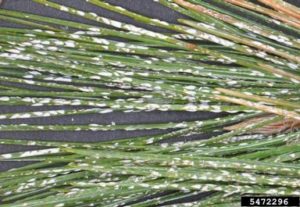
Pine needle scale, Chionaspis pinifoliae, is one of the most common armored scales found on conifers in the United States. Sometimes referred to as white scale, this plant-sucking insect damages evergreens through feeding on the tree’s sap. Pine needle scale causes stunted growth, wilting of leaves/needles, yellowing of leaves/needles, and an overall decrease in vigor. From a distance, the tree may look frosted or silvery. Heavy infestations can lead to branch dieback and possibly death.
Species Targeted: Pines including; Mugo Pine, Scotch Pine, Red Pine, and Eastern White Pine, Spruces, White Fir, Douglas Fir, and Cedars.
Learn More About Pine Needle Scale
2. Spruce Spider Mites
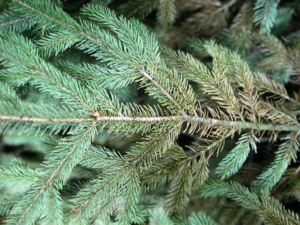
The spruce spider mite (Olibonhychus ununguis) is a cool-season mite native to North America. This insect is one of the most destructive kinds of spider mites for Evergreens. These mites thrive during the spring and fall causing stippling on needles, yellow or rust-colored needles, premature needle drop, and fine webbing in needles. Damage is typically heaviest at the bottom and inside of the tree. Spruce spider mites grow rapidly in population and can cause a lot of damage before you even notice a problem.
Species Targeted: Spruce spider mites prefer Colorado blue spruce, Norway spruce, dwarf Alberta, and white spruce. But despite its name, it will also feed on arborvitae, cedar, dawn redwood, Douglas fir, hemlock, juniper, larch, and pine.
Learn More About Spruce Spider Mites
3. Bagworms
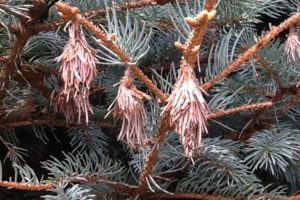
Bagworms, found throughout the Eastern United States, are a major pest for evergreens. These insects are known for the cone-shaped bag they create around themselves, hence their name. These insects damage trees by feeding on their foliage. Most trees will see partial defoliation; however, some heavily infested trees will experience complete defoliation. The greater the amount of defoliation the greater amount of stress is put on the tree which can lead to other health issues like insects and fungi that prey on weakened trees.
Species Targeted: Arborvitae and Red Cedar are the bagworm’s most favorite host but Cypress, Juniper, Pine Spruce, Apple, Birch, Black Locust, Elm, Maple, Poplar, Oak, Sycamore, Willow and over 100 other species are also attacked by the pest.
Learn More About Bagworms
4. Sawflies
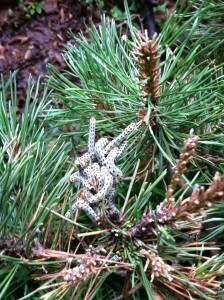
Sawflies despite the name are not flies at all; they belong to the wasp family and can completely defoliate your evergreens in a few short days. The sawfly larva is actually what feeds on trees and plants causing damage. Larvae tend to look like caterpillars with three large legs and seven smaller false legs. Although they may appear individually they are typically seen in groups that feed on the leaves and needles of plant life. Signs of sawflies include; holes or papery spots along leaf midribs, brown & wilted needles, stunted tree growth, skeletonized leaves, patchy/missing foliage. If Sawfly infestations are left untreated they will rapidly defoliate Spruces, Cedars, and Pines. Early intervention is key to keep your evergreens from becoming Sawfly victims.
Species Targeted: Spruce, Cedar, & Pine
Learn More About Sawflies
5. Winter Burn
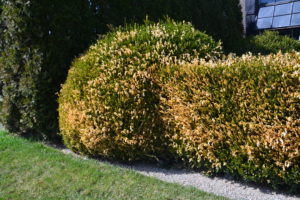
Winter burn is an unsightly and possibly deadly condition that affects all evergreens. It causes your evergreen needles/leaves to die and turn brown and can have a big health impact on the tree. Unlike others on this list, winter burn is not caused by a fungus, disease, or insect. This unsightly browning of Evergreens stems and the health conditions that follow are caused by a cycle called desiccation.
Desiccation is the process where trees and shrubs lose moisture through their pores which are located on their leaves/needles. During the winter months, the dry air and wind accelerate this effect leading to leaves increasing their water demand from the roots in order to survive. However, the root system usually has a hard time keeping up with the leaves’ demand. This is usually because the roots weren’t able to store enough water before winter and now can’t absorb it from the frozen ground. The result: leaves and needles turning brown and dying.
Species Targeted: Winter burn can affect all evergreens but is most commonly found on Boxwood, holly, rhododendron, fir, hemlock, pine, spruce, yew, arborvitae, false cypress, and juniper. Sometimes the placement of a tree/shrub makes it more vulnerable to winter burn as well. For example, trees that act as windbreaks, are in open unprotected areas, or in sunny areas are more susceptible. The age of the tree matters as well. Younger trees with less established root systems are more susceptible than older, well-established trees.
Learn More About Winter Burn
6. Cytospora Canker Disease
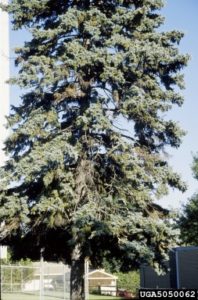
Cytospora canker disease, also know as Leucostoma canker, is one of the most damaging diseases of spruces especially the Colorado Blue Spruce. This disease is caused by the fungus Leucostoma kunzei, which grows throughout the inner bark causing the portion of the tree behind the canker to die. Cytospora canker disease is most common on large mature trees and is spread by splashing raindrops, wind, and insects. Symptoms include branch dieback that starts at the bottom and progresses up the tree, loss of vigor, bluish-white resin (flowing or dried) coating tree branches.
Species Targeted: Colorado Blue Spruce (and it’s varieties), Norway spruce, Koster’s blue spruce, white spruce, other spruces, and Douglas firs.
Learn More About Cytospora Canker Disease
Now that you know some of the most common evergreen problems you can be on the lookout for signs and symptoms in your landscape. Think your evergreen is suffering from one of the issues we mentioned above? Our Arborists can help! Give us a call at 703.573.3029 or book an appointment through our online scheduling system for help with all your Evergreen needs.
